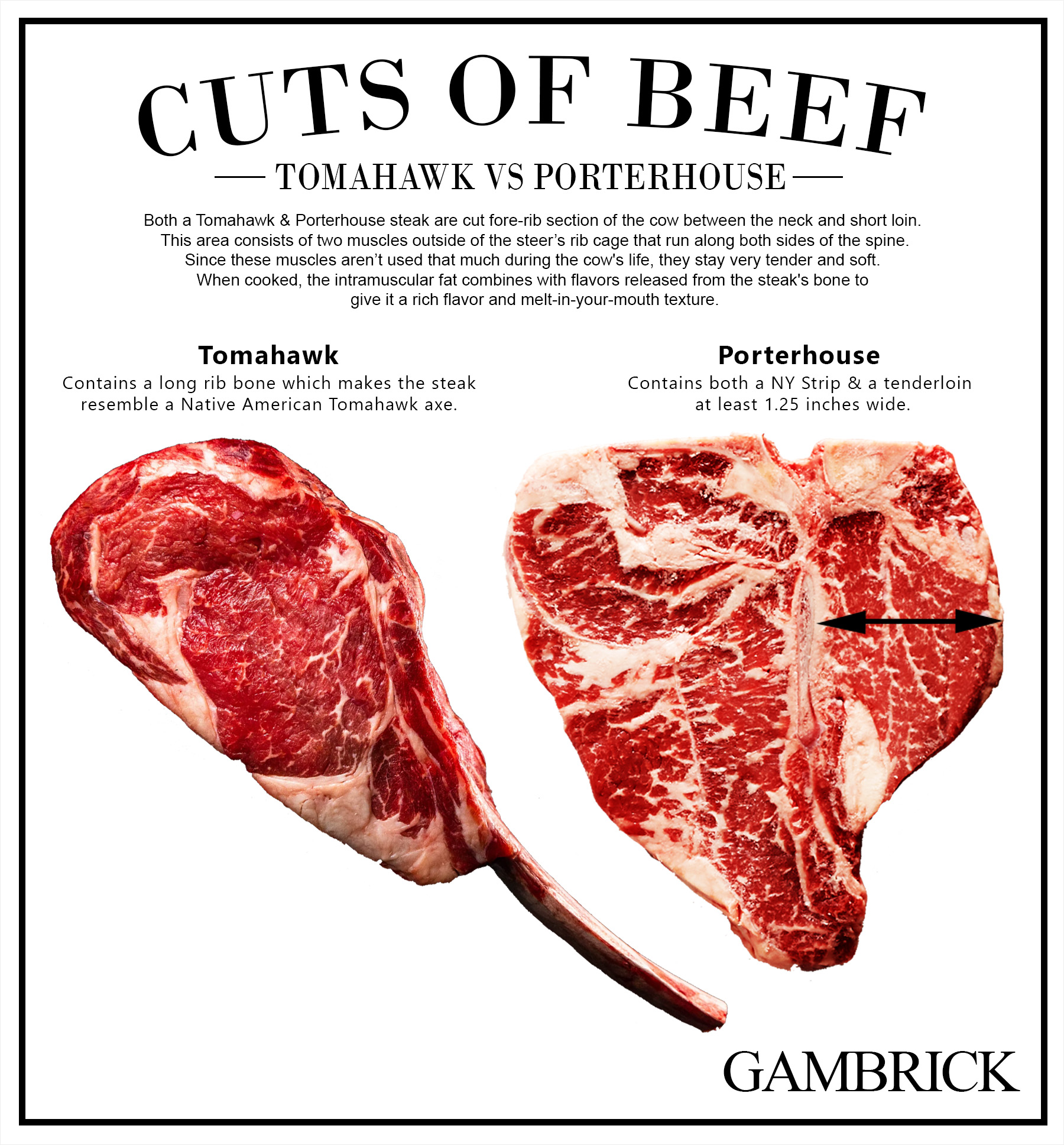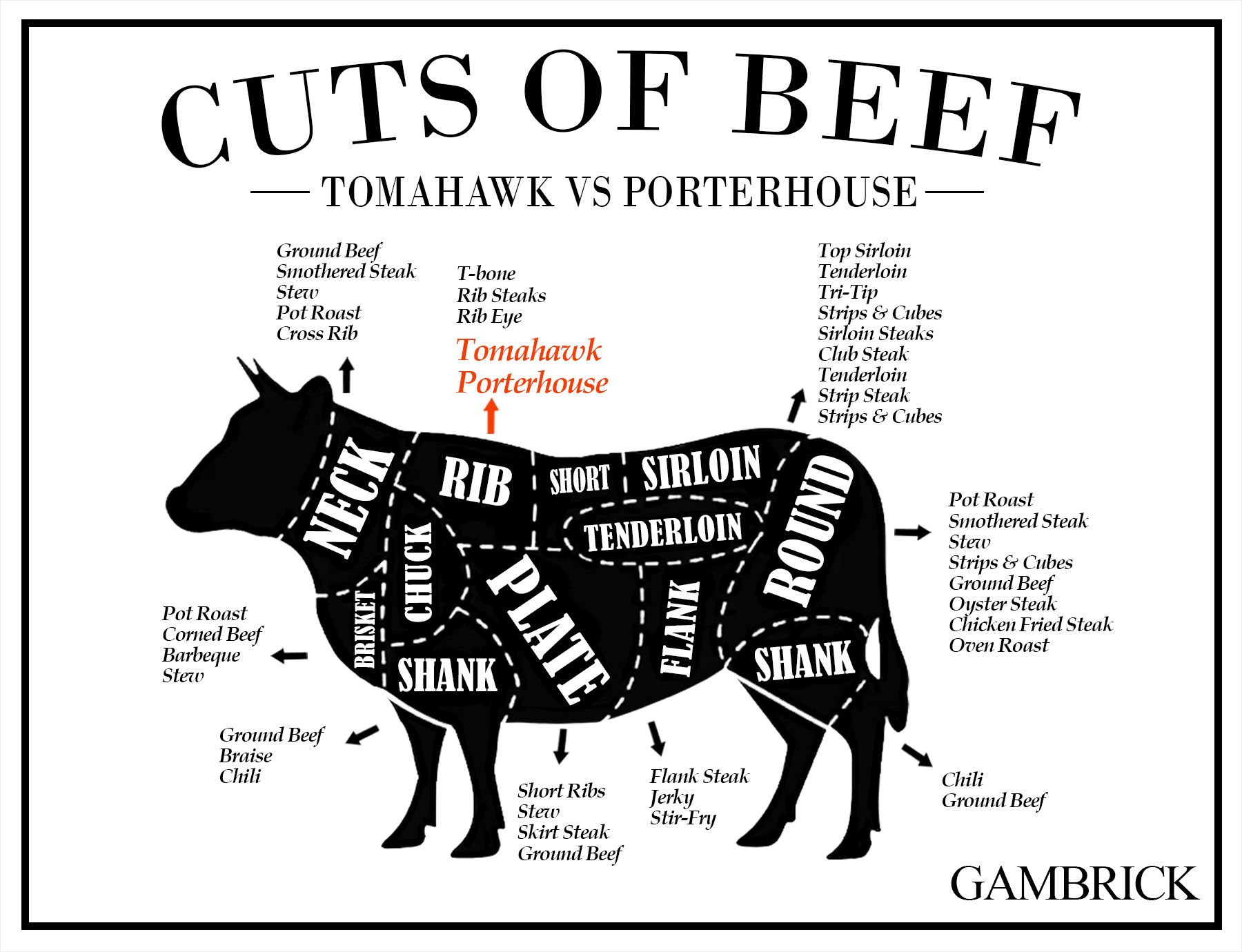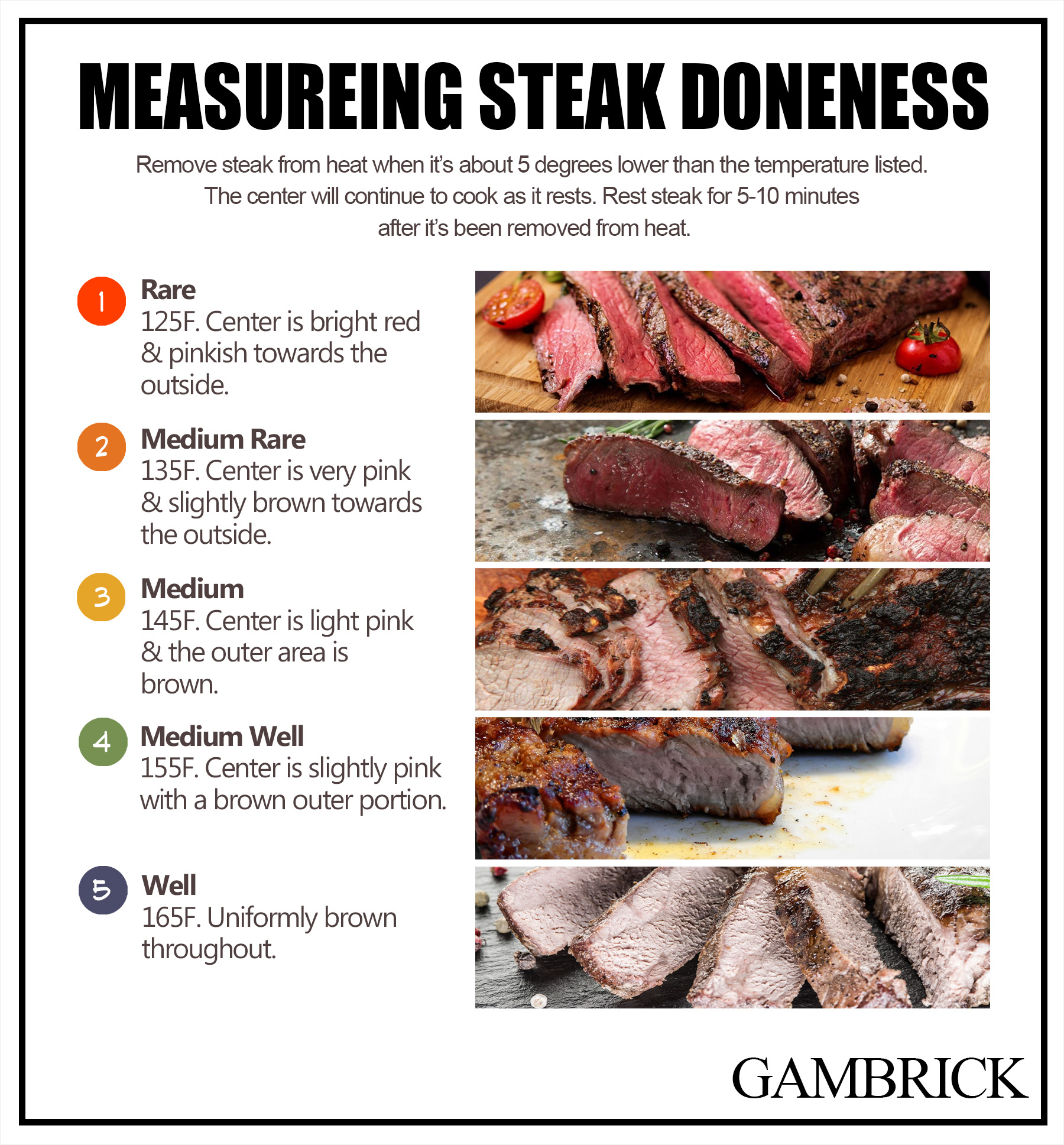Tomahawk vs Porterhouse Steak
The tomahawk steak is a ribeye beef steak cut with at least five inches of rib bone left intact. It’s cut from the fore-rib section of the cow between the neck and short loin. This area consists of two muscles outside of the steer’s rib cage that run along both sides of the spine. This is also the main muscle found in a Porterhouse steak. The long and slender bone is french trimmed to resemble the handle of a Native American tomahawk axe (hence the name). It’s also referred to as a “tomahawk chop” or a “bone-in ribeye.” As a bone-in rib steak, Tomahawks have a large amount of inter-muscular fat and a huge bone which both give the steak loads of flavor. The meat is tender, juicy, flavorful and well marbled.
A Porterhouse steak is actually two cuts of meat in one: a tenderloin and a top loin. The top loin of a Porterhouse is cut from the same rib section of meat as a Tomahawk. So the flavor, texture and marbling of both steaks is about the same. But a Porterhouse has the rib bone trimmed off and contains a filet. This is where the differences begin.
When a Tomahawk is cooked correctly, loads of rich flavor is drawn from the bone. This is something you lose when cooking a Porterhouse. But a Porterhouse also has an extremely tender cut of filet.
Both steaks are full of fantastic beef flavor, tender, juicy and really large. For most people they’re a meal big enough for two.
When comparing a Tomahawk vs a Porterhouse steak there’s no clear winner. They’re both fantastic steaks. If you prefer the taste of a bone-in ribeye choose a Tomahawk. But if you like that super tender filet go with a Porterhouse.
The Similarities Between A Porterhouse & Tomahawk Steak
Tomahawk and Porterhouse steaks are types of meat that are both cut from the rib area of a cow. But they look very different because a Tomahawk keeps the rib bone attached and the Porterhouse does not.
These highly marbled, very tender and flavorful steaks are primarily taken from the longissimus dorsi, or loin, of the steer. The area consists of two muscles outside of the steer’s rib cage that run along both sides of the spine.
Since these muscles aren’t used that much during the cow’s life, they stay very tender and soft. When cooked, the intramuscular fat combines with flavors released from the steak’s bone to give it a rich flavor and melt-in-your-mouth texture.
Right behind the rib section of a cow is the loin. A Porterhouse steak contains a piece of loin, called a filet, in addition to its top loin cut. This is what defines a Porterhouse. Your actually getting two steaks in one.
A Tomahawk has the same large cut of meat as a Porterhouse, without the filet, but the rib bone stays attached. This gives the steak a different flavor when properly cooked.
Since most of the meat on a Tomahawk and Porterhouse are the same, the flavor and texture is also the same. The difference lies in that long bone and the filet.
When you cook a Tomahawk lots of rich flavor is drawn from that huge bone into the steak. This is something you lose with a Porterhouse. However you gain a super soft and tender filet.
Both steaks are great. You really can’t go wrong with either cut. I recommend trying each to find out which one you prefer.
What Makes A Porterhouse Steak
Did you know that a Porterhouse steak is almost exactly the same as a T-bone.
Both a T-bone and Porterhouse are cut from the exact same section of beef and both contain a NY strip and a tenderloin filet. But the United States Department of Agriculture (USDA) has strict rules about how much beef must be on a steak to be called a Porterhouse.
So what sets a Porterhouse apart from a T-bone? The difference between Porterhouse vs T-bone steak is the size of the filet.
For a T-bone steak to qualify as a Porterhouse, the USDA says the filet must be at least 1.25 inches thick. Thickness is measured from the bone to the widest point on the filet.
Porterhouse steaks are cut from the rear of the short loin, where the tenderloin is thickest. The result is a larger cut of steak. A T-bone contains the same NY Strip and Filet but its cut from an area that’s a bit smaller. The filet falls under the 1.25 inch thick requirement.
So what makes a Porterhouse? They’re a big steak with one section of NY Strip and at least a 1.25 inch thick filet separated by a T shaped bone.
What Makes A Tomahawk Steak?
The tomahawk steak is a ribeye beef steak cut with at least five inches of rib bone left intact. The extra-long bone is french trimmed using the same culinary technique that shapes a rack of lamb. “Frenching” means trimming the meat bone and fat to the point where it looks like a handle.
This gives the steak its rich flavor and famous look which resembles a Native American tomahawk axe (hence the name). It’s also be referred to as a tomahawk chop, bone-in ribeye or cote de boeuf.
A Tomahawk and a traditional ribeye are technically the same steak. The difference is in the french trimming Essentially, Tomahawk steaks are just big ribeyes with some fancy trimming to make them look like an axe.
Authentic tomahawk steaks are 1 to 2 inches thick and at least a foot long with the bone. Since the bone is usually about 5-6 inches long that leaves around 6-7 inches of meat. They usually weigh about 3 to 4 pounds, which is a very larger portion of steak.
Tomahawks are a highly marbled, very tender and flavorful steak. It’s primarily cut from the longissimus dorsi or loin of the steer. This area consists of two muscles outside of the steer’s rib cage which run along both sides of the spine. It’s also the main muscle of a Porterhouse steak.
Since these muscles aren’t used much by the cow they stay tender and soft.
When a Tomahawk is properly cooked, its marbling combines with the flavors released from its large bone to give the steak a wonderfully rich beef flavor. It’s also melt in your mouth tender and fairly lean once you trim away the larger chunks of fat.
Tomahawk Vs Porterhouse Price
For either cut, steaks marked with USDA Prime will have the highest cost, but this is true for just about any steak cut. Steaks with a USDA Prime stamp are considered nearly perfect with excellent marbling.
Both a Porterhouse and a Tomahawk are considered premium cuts of steak on par with a Ribeye, NY Strip, T-Bone or Tenderloin. And they tend to be very large steaks often eaten by two. Because of the high quality and large size, both steaks are quite expensive.
- A USDA Prime Porterhouse steak costs about $2 per ounce or $32 per pound. An average size Porterhouse weighing approximately 36 oz and costs around $72.
- A USDA Prime Tomahawk steak costs about $1.75 per ounce or $28 per pound. An average size Tomahawk weighing approximately 36 oz and costs around $65.
Overall a Porterhouse steak is slightly more expensive than a Tomahawk by weight. But this is deceiving because a large part of a Tomahawk is the handle shaped bone. If you cut away the bone from both the Porterhouse and Tomahawk and weigh the two steaks, the Porterhouse is cheaper because you get a lot more meat.
Another factor to consider is that a Porterhouse comes with both a NY Strip and a Filet cut of steak. A USDA Prime Filet can sell for $6.25 per oz. Since a Porterhouse steak must contain at least a 1.25 inch wide filet to be called a Porterhouse, and they’re usually 1 1/4 inches thick, that’s about 6 oz of filet worth around $40.
Ultimately the cost difference between the two steak comes down to a variety of factors, like quality, size, age, and where you buy them.But the Porterhouse is usually more expensive even though it’s the better deal.
Best Wine To Pair With Tomahawk Vs Porterhouse Steak
Red wine is what you should pair with a steak. It’s an easy rule to remember – red meat with red wine.
Beef is usually eaten with a red while a “white” meat like chicken or fish is generally served with a white. Pork doesn’t fit into either category so it can be paired with either.
A full-bodied, moderately robust red wine like a Cabernet Sauvignon is a great wine to pair with both a Tomahawk or Porterhouse steak.
You can’t go wrong with a good cabernet. There’s a wide variety of cabernets available and they usually have a well balanced flavor that’s perfect for steak. Cabernets have a high acidity that cuts through fatty rich foods, providing a tang that’s absolutely fantastic with a good steak.
Zinfandel is a great choice if you like a sweeter sweeter wine with your steak. Zinfendels have a high sugar content, so they’re best paired with a spicy steak and not with a sweet one that’s been glazed. This makes it a great pair with most Porterhouse and Tomahawk steaks which are generally seasoned with salt and pepper.
Syrah (Shiraz) varietal is another great choice with marbled steak. Cuts of steak with marbling go well with a more robust wine to balance them. The wine provides a counter-balance to the richness of the fatty, marbled meat.
The terms Syrah and Shiraz are interchangeable, so you may see either terms on a menu. There’s a bit of variety within the wine because the grapes that make it are heavily influenced by the temperatures in which they grow.
These are some solid wine choices that will pair well with either a Tomahawk or Porterhouse steak. But experiment a bit with your wine and steak pairings to find what you like best.
Cooking Porterhouse Vs Tomahawk Steak
A Porterhouse or Tomahawk will cook similarly because they come from the same part of the cow and have the same texture.
The key difference when cooking them is the Tomahawk’s large bone and the sheer size of a Porterhouse.
- Because a Porterhouse is so large it requires more time to cook vs the Tomahawk.
- A Tomahawk has a huge 5+ inch bone which can add flavor to the meat.
Both steaks can be cooked the same way. They’re great grilled, cooked in an oven, or with a cast iron skillet or pan. However, there are some benefits to cooking a Tomahawk in either a pan or an oven because of the bone. Cooking draws out some deep rich flavors from the bone which you can’t get from a grill.
Both steaks are fantastic when pan seared in a hot cast iron skillet and then finished on the grill or in an oven. That’s how they’ll come in most steak houses and fine dining restaurants. But they’re great cooked on a hot grill with some salt and pepper or a rub.
Season both steaks with salt and pepper generously before cooking to help it brown with a nice crust.
Once a crust forms, finish the steak in an oven or move it to a cool area of the grill until it reaches the right internal temperature. This method slowly cooks the inside without overcooking the outside.
Grilling a steak deepens its already delicious flavor and gives it beautiful grill marks you can’t get from a pan. Top your steak with mushrooms, onions, peppers or your favorite steak sauce.
When Is My Porterhouse Vs Tomahawk Steak Done Cooking?
To know for sure when a steak is done cooking you need an accurate meat thermometer. This is especially important when cooking thick steaks like a Porterhouse or Tomahawk. With thicker steaks it’s very easy to sear the outside and still have an under-cooked inside.
Insert the thermometer into the center of the meat and take a reading. Reference the temperature chart above or the list below to know which internal temperature is with what level of doneness.
- Rare: 125°F. The center will be bright red with some pink on the outer edges.
- Medium Rare: 135°F. The center is very pink and slightly brown towards the outside.
- Medium: 145°F. The center is light pink and the outer area is brown.
- Medium Well: 155°F. The center is slightly pink with a brown outer portion.
- Well: 165°F. Uniformly brown throughout.
Once the steak is at the correct level, take it out of the pan, oven, or grill, and lay it on a cutting board. Let the meat rest for five to ten minutes. This lets the juices settle throughout the meat which creates a more tender and juicy steak.
Try topping your steaks with a little butter, sea salt and/or black pepper as a finishing touch.
Is Tomahawk Steak The Best Steak?
Tomahawk steak is one of the best steaks you can buy and definitely worth the money if you’re a steak fan. They’re tender, juicy and full of flavor. When cooked correctly in a pan or an oven the long 5+ inch handle bone adds a rich flavor you can’t get from any other steak.
The bone is what gives a Tomahawk its special place among steak fans. Aside from its Native American Tomahawk Axe appearance, the bone is all about flavor. Try slow cooking your Tomahawk in a pan or an oven after a good sear to unlock tons of bold flavor.
Without the bone, a Tomahawk is just a ribeye, which is still a very high quality steak and also worth the money. The meat is soft, tender, well marbled and juicy.
Is a Tomahawk steak the best steak? It’s definitely in the top 6 cuts of steak you can eat along with Filet, Porterhouse, Ribeye, T-Bone and a NY Strip.
Is Porterhouse Steak The Best Steak?
Porterhouse steak is one of the best steaks you can buy and well worth the money. They’re tender, juicy and full of flavor. And they’re extremely large at over 1 1/4 inches thick which makes them a great meal for two.
A Porterhouse is a unique steak because it’s actually two cuts of steak in one. A NY Strip and a Filet. Both of which are two of the best steaks money can buy. A NY Strip is very tender and juicy but nothing matches the soft texture of a filet. And a Porterhouse gives you a big portion at least 1.25 inches wide.
Porterhouse is great when cooked in a pan, oven or on a grill. Get a good sear and then finish slow cooking its center on low heat. Flavor with salt and pepper or a high quality rub.
Is a Porterhouse steak the best steak? It’s definitely in the top 4 cuts of steak you can eat along with a Ribeye, T-Bone and Tomahawk. And in case you were wondering why a Filet and NY Strip aren’t on this short list of top steaks, its because a Porterhouse is both a NY Strip and a Filet.
Nutritional Value Of Porterhouse & Tomahawk Steak
One pound of Porterhouse or Tomahawk can easily top 1,000 calories. This is in addition to all the other things you may eat along with the beef.
A serving size of steak is considered 3 ounces. For both a Porterhouse and Tomahawk this equals about 200-250 calories per serving.
The Porterhouse and Tomahawk are both low in carbs with about 20-25 grams of protein per serving. Like most steaks, they’re also an excellent source of iron, phosphorus, riboflavin, zinc, Vitamin B6, and other essential vitamins and minerals that your body needs.
Be careful about eating too much of the fat. Much of the marbling will cook into the beef but you’ll still have large section of thick intramuscular fat with both steaks. Cut those away to save on calories.
Throw in a baked potato, vegetable and/or green salad along with your steak for a well balanced and nutritious meal.
Storing Steak
A Porterhouse or Tomahawk steak can both be safely stored in the refrigerator for up to two days after you buy it, unless the “Sell By” date is before that time.
Both a Porterhouse and Tomahawk steak should look deep red without a slippery film or an unpleasant smell when you’re ready to cook it. If you notice a film or there’s any sort of weird smell I wouldn’t cook it.
If you won’t be able to cook your steak within 2 days of buying it, place it in a freezer storage bag, remove as much air as possible and then place it in the freezer. Most steaks can safely stay frozen for 6-12 months before eating them.
How Many Tomahawk Steaks Per Cow?
A cow can provide as many as 14 tomahawk steaks depending on its size. However a Tomahawk is cut from the same area of the cow as a Porterhouse, Ribeye and T-Bone steak. So most butchers will cut between eight and ten tomahawk steaks, leaving the rest for Ribeyes, T-Bones and Porterhouse steaks.
Summary: Tomahawk vs Porterhouse Steak
The tomahawk steak is a ribeye beef steak cut with at least five inches of rib bone left intact. It’s cut from the fore-rib section of the cow between the neck and short loin. This area consists of two muscles outside of the steer’s rib cage that run along both sides of the spine. This is also the main muscle found in a Porterhouse steak. The long and slender bone is french trimmed to resemble the handle of a Native American tomahawk axe (hence the name). It’s also referred to as a “tomahawk chop” or a “bone-in ribeye.” As a bone-in rib steak, Tomahawks have a large amount of inter-muscular fat and a huge bone which both give the steak loads of flavor. The meat is tender, juicy, flavorful and well marbled.
A Porterhouse steak is actually two cuts of meat in one: a tenderloin and a top loin. The top loin of a Porterhouse is cut from the same rib section of meat as a Tomahawk. So the flavor, texture and marbling of both steaks is about the same. But a Porterhouse has the rib bone trimmed off and contains a filet. This is where the differences begin.
When a Tomahawk is cooked correctly, loads of rich flavor is drawn from the bone. This is something you lose when cooking a Porterhouse. But a Porterhouse also has an extremely tender cut of filet.
Both steaks are full of fantastic beef flavor, tender, juicy and really large. For most people they’re a meal big enough for two.
If you have any questions or comments about steak email any time.
























